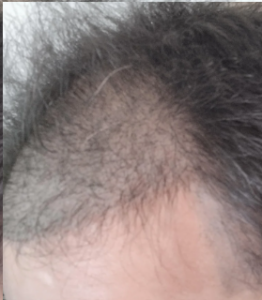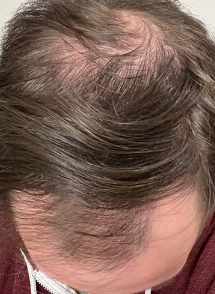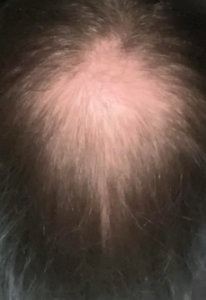Me: I am a 24 year old diffuse thinner. I started balding at 22. I still have hair on my head but it’s thin and just looks very patchy if the wind blows it away. My problem: How do y’all deal with your hair loss? From 18-22 I was a very energetic, very confident person, I always talked to girls and had no fear of social interactions. Nowadays my confidence is gone and I just don’t enjoy social gatherings and life itself like I used to. Hair loss really controls my energy and my happiness, I wish I could have had my full head of hair at least till I’m 30… I am looking in every mirror I pass by, I have countless of hair pictures in my gallery it really drains my energy to the point where I am just always exhausted. My regime: I am on minoxidil for exactly a year right now with no results (derma rolling 1x a week with a derma pen m8 since march) I also take fin 1mg every second day since march. I scalp massage and use keto shampoo every other day as well. There is no change at all…
I feel for you. Over the past 33 years in practice, I have heard similar comments. What is interesting to me is that the celebrities and top business people I transplanted were able to put aside their feelings, like yours, and focus on their lives. I understand how hair loss preoccupies too much of our activities to stop us from going where we need to go. Get a great doctor to evaluate you for a hair transplant if you have tried all of the regular medications and treatments to date. Are you sure that you are doing everything needed to grow back your hair short of a hair transplant? If so, explore the transplant solution with good research.
I am excited to see what it will look like at 6 months
If you read my 6/21/24 post, I discussed the number of grafts and its relationships with the size of the recipient area. Most average Caucasian men have about 7000-8000 grafts (plus or minus 20%) to take from the donor area for their lifetime. Asians and Africans have significantly less donor hair. Are you old enough to know your final balding pattern (over 26, at the least)? 4100 grafts should be more than enough to return your normal donor density to the area you transplanted. What worries me is that if you become significantly bald in your late 20s or early 30s, you will need more hair to take from the donor area. You might be unable to supply a balding Class 6 or 7 pattern, possibly resorting to beard hair if that happens. I believe that every person having a hair transplant needs a personalized Master Plan that considers their worst-case projected hair loss pattern, the value of their hair (fine, medium, or coarse), and the quantity of hair that can be harvested from the donor area (that is a number that is easily measured and calculated). With that plan in place, there are never surprises. If your surgical team did their job correctly, as I see it looks good, you would have more than enough hair for the balding you presented with.
Old Drug Now Called a “Magic Pill”, because it regrows hair and improves heart health (earth.com). The article suggests that Finasteride could lower cholesterol levels and reduce the risk of heart disease. Dr. Jaume Amengual, Assistant Professor at the University of Illinois, said, “men in a survey had a Cholesterol level 30 points lower than those not taking the drug”. This data came from the National Health and Nutrition Survey conducted between 2009 – 2016 on thousands of men over 50, but the sample of men in the actual study was small where the Cholesterol was analyzed. The study was taken to the laboratory, and mice prone to atherosclerosis and fed on a high-fat, high-cholesterol diet showed lower serum cholesterol levels and decreased inflammatory markers in the liver. The study suggested that with the high dose of finasteride given to the mice, there was less atherosclerosis in the coronary arteries and fewer inflammatory markers in the liver.
Hello, I am currently a 20 year old college student with a big hairline recession and also thinning hair. It is not that bad, but it is definitely something that is causing me a lot of anxiety and stress. I am entering my 6th month on finasteride and have been on and off minoxidil for about a year. I have not seen any progress and fear it is just getting worse. I really want to get a transplant but feel I may be too young. Any advice on when in life is best for this or if finasteride will eventually start working?
Don’t do a hair transplant until you are at least 25-6. At that time, your final pattern of balding will be evident, and you can build a personalized master plan with a good doctor for your future hair loss, which will continue to occur even at 26. Finasteride will slow, stop, or reverse the hair loss. It is not uncommon for reversal at age 20.
It looks like the surgeon went well outside of the donor area. That means that those grafts, might only survive in the short term (if the work was well done), and if your balding pattern would eventually extend to the areas that they were removed from. How many grafts did you have done? Did you know that African men have significantly fewer hairs per graft (follicular Units) than either Asian or Caucasian men? That means you have more limits on how much actual harvesting you can tolerate without going bald in the back of the head. Be careful.
The first photo shows the transplanted area. The second photo shows the donor area with arrows that show the problem you may confront. More grafts may be out of the question.
Click to Enlarge Photo
I feel like this 100 hair a day thing is misleading for people that are shedding. I for example lose 200+ hair a day, and thats when I do a rough count in the shower and sink(when applying minoxidil). But if I ask a friend or my brother how much they lose in the shower they say little to none (single digits). If they run their hand through their hair or comb it a bunch, they still lose little to none. So how is this 100+ hair fall a day supposed to be accurate. Also most of us that have visible scalp already lost 50% or more of our density, so shouldn’t our normal already be 50 hair or lower per day?
The actual hair loss per day reflects:
1- How many hairs do you have on your head. A Typical Caucasian has 110,000, and a Typical Asian has 95,000.
2- What is your growth cycle. Hair grows in cycles and we lose long hair when hair goes out of its growth cycle (anagen) and into its sleep (telogen) cycle. For an average young man in his early 20s, the growth cycle is between 2 1/2 to 3 years. Assuming that it is 3 years, do the math, 100 hairs per day are about 100 hairs per day in a typical Caucasian male. With 365 days per year, 100 hairs lost per day would deplete the existing hair population by 36,500 hairs in a year, but the telogen hairs come back to life at the same rate of 36,500 hairs per day, giving a non-balding male a net zero for hairs lost on the head. Asians, of course, have lower numbers by 15 – 20%, and Africans are still lower by 30% compared to Caucasians. On the other hand, women tend to have longer hair cycles, some as long as 6-7 years, reflecting a very low number of hairs lost per day.
3- Balding: Balding adds hair loss to the above equations. When a young man has hair loss, that hair loss is in addition to his normal 100 hairs per day, so it becomes more evident in the shower or on the bed pillow.
4- Most normal men lose their hair in the wind, in the shower, walking around at work or at the house. The amount is so small that it is not noticed; however, when balding occurs, the extra volume of lost hairs becomes very detectable.
I have been using finasteride for a few years and saw no real regrowth but my hair loss was definitely stable. I started to incorporate 5% topical min 2 times a day and dermarolling once a week to go with my fin.
It is clear to me that the microneedling is what brought your hair back, helped by the other medications. More time and more microneedling will only make it better.
Doc, why does some SMP turn blue ? Also in your practice what type of needle do you use? Some say a one 1RL needle is better than a three 3RL ?
Black inks when placed in the scalp, often look blue. This is due to the trichometic principles of light (https://encyclopedia2.thefreedictionary.com/trichromaticity). A good SMP operator doesn’t use pure black ink, but modifies the ink colors, many times using a brown ink. To get the color delivered in a reasonable timeframe, many operators use the 3 needle arrangement to keep control over costs.
Hi, I recently noticed a few months ago, that my hairline has taken a step back compared to 15 year old me, (I’m 19 now), I’m a NW2ish (Maybe slightly better or worse, unsure). I don’t particularly hate my hairline, (closest comparison would be Harry styles/leo DiCaprio widows peak w/o posting pictures) so maintaining it is my goal, however I’ve seen several posts on here about shedding, sometimes long term shedding, with the before and after pictures looking very scary.
How common shedding is on Fin, and how severe shedding usually is for most people? Appreciate any answers and reassurance.
If you have early hairline recession or balding at 19, you are almost sure to get more as you get older until you reach your inherited family pattern. Look at family photos, especially of all the men (uncles, grandparents, brothers, even cousins), and see if you take after anyone. The point of starting treatment early, at 19, with the proper medications, gives you the best chance of avoiding that family pattern you might have inherited. Only worry if you don’t treat early balding.
Page 4 of 1237














